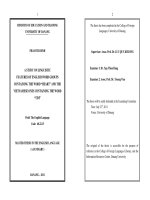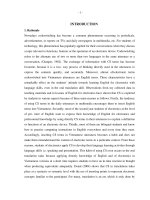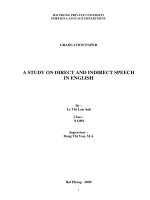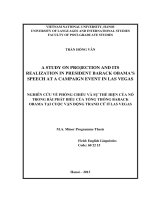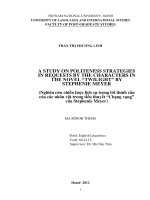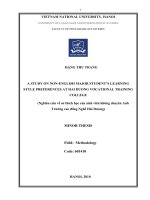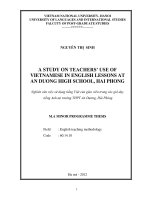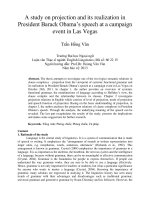a study on theme-rheme and cohesive ties in the short story the last leaf” by o’henry nghiên cứu về tổ chức đề thuyết và các mối liên kết trong truyện ngắn chiếc lá cuối cùng của o’henry
Bạn đang xem bản rút gọn của tài liệu. Xem và tải ngay bản đầy đủ của tài liệu tại đây (2.16 MB, 96 trang )
VIETNAM NATIONAL UNIVERSITY - HANOI
UNIVERSITY OF LANGUAGES AND INTERNATIONAL STUDIES
FALCULTY OF POST-GRADUATE STUDIES
VŨ THỊ THANH NGA
A STUDY ON THEME – RHEME AND COHESIVE TIES IN
THE SHORT STORY “THE LAST LEAF” BY O’HENRY
NGHIÊN CỨU VỀ TỔ CHỨC ĐỀ THUYẾT VÀ CÁC MỐI LIÊN KẾT
TRONG TRUYỆN NGẮN CHIẾC LÁ CUỐI CÙNG CỦA O‟HENRY
M.A. Minor Programme Thesis
Field: English Linguistics
Code: 60.22.15
Hanoi – 2013
VIETNAM NATIONAL UNIVERSITY - HANOI
UNIVERSITY OF LANGUAGES AND INTERNATIONAL STUDIES
FALCULTY OF POST-GRADUATE STUDIES
VŨ THỊ THANH NGA
A STUDY ON THEME – RHEME AND COHESIVE TIES IN
THE SHORT STORY “THE LAST LEAF” BY O’HENRY
NGHIÊN CỨU VỀ TỔ CHỨC ĐỀ THUYẾT VÀ CÁC MỐI LIÊN KẾT
TRONG TRUYỆN NGẮN CHIẾC LÁ CUỐI CÙNG CỦA O‟HENRY
M.A. Minor Programme Thesis
Field: English Linguistics
Code: 60.22.15
Supervisor: Prof. Dr. Hoàng Văn Vân
Hanoi – 2013
i
DECLARATION
I, hereby, certify the thesis entitled “A STUDY ON THEME – RHEME AND
COHESIVE TIES IN THE SHORT STORY “THE LAST LEAF” BY O’HENRY” is the result of my
own research for the Minor Degree of Master of Arts at the University of Language
and International Studies, Vietnam National University, Hanoi, and this thesis has not,
wholly or partially, been submitted for any degree at any other universities or
institutions.
Hanoi, 2013
Vũ Thị Thanh Nga
ii
ACKNOWLEDGEMENTS
I would like to express my deep gratitude towards my supervisor, Prof. Dr. Hoàng Văn
Vân, for his constant and invaluable assistance without which my study would be far
from finished.
I greatly wish to acknowledge my thanks to Dr. Đỗ Tuấn Minh whose research on
Thematic Structure in English and Vietnamese has helped me much during my study.
I am also greatly indebted to all my colleagues at Ben Tam High School who provided
me with valuable materials and enthusiastic support on the aspect of my research.
Finally, my sincere thanks go to my beloved family for their love, encouragement, and
support while I was carrying out this research.
Hanoi, August 2013
Vũ Thị Thanh Nga
iii
ABSTRACT
This study is an attempt to apply systemic functional grammar to investigating a short
story “The Last Leaf” by O‟Henry in terms of the theme – rheme structure and
cohesive ties. Based on the theory of systemic functional grammar as developed by
Halliday, the study focuses on the analysis of O‟Henry‟s story “The Last Leaf” in
terms of the textual metafunction which is represented via theme - rheme pattern, and
cohesion (grammatical cohesion and lexical cohesion) of the text. The findings show
that in terms of theme - rheme pattern, topical theme which forms unmarked one is the
most striking feature of the text. We can also realize how the author develops the text
and creates a surprise ending which makes the story one of O‟Henry‟s masterpiece.
Moreover, grammatical cohesion represented by reference and conjunctive devices and
lexical cohesion shown via repetition, synonyms, meronyms and antonyms make the
text more cohesive and coherent. The analysis proves that systemic functional
grammar is the smartest choice for those whose concern is for the structure and
meaning of a particular text.
iv
TABLE OF CONTENTS
ACKNOWLEDGEMENTS
ABSTRACT
TABLE OF CONTENTS
LIST OF MARKERS AND ABBREVIATIONS
LIST OF TABLES
CHAPTER 1: INTRODUCTION ……………………………………….….1
1.1. Rationale of the Study ………………………………………………………… 1
1.2. Aims of the Study .……………………………………………………………….3
1.3. Scope of the Study .….………………………………………………………… 3
1.4. Method of the Study .…………………………………………………………….3
1.5. Data Collection ……………………………………………………………… 4
1.6. Design of the Study …………………………………………………………… 4
CHAPTER 2: THEORETICAL BACKGROUND … …………………….5
2.1. Introduction ……………………………………………………… ………….…5
2.2. The Linguistic System ………………………………………………………… 5
2.3. Metafunctions …………………………………………………… ………….….6
2.3.1. Ideational Metafunction ……………………………………… 6
2.3.2 Interpersonal Metafunction …………………………………… 7
2.3.3. Textual Metafunction ………………………………………… 8
2.4. Cohesion .……………………………………………………………………… 11
2.4.1. Concept of Cohesion…………………………………………….…… 11
2.4.2. Types of Cohesion ………………………………………………… …12
2.4.2.1. Grammatical Cohesion …………………………………… 12
v
2.4.2.2. Lexical Cohesion………………………………………… ….16
2.5. Concluding Remarks ………………………………………………………… 18
III. CHAPTER 3: THEME – RHEME AND COHESIVE TIES IN THE
SHORT STORY “THE LAST LEAF” BY O’HENRY
3.1. Introduction …………………………………………………………………… 19
3.2. The Context of the Chosen Text ……………………………………………… 19
3.3. The Analysis of the text in terms of Theme – Rheme…………… ………… 19
3.3.1. Topical Theme………. ……………………………………………… 21
3.3.2. Interpersonal Theme……………………………………………………23
3.3.3. Textual Theme………. ……………………………………………… 24
3.3.4. Marked and Unmarked Theme…………………………………………25
3.4. The Cohesion of the Text …………………………………………………… 29
3.4.1. Grammatical Cohesion ……………………………………………… 29
3.4.2. Lexical Cohesion ………………………………………………………39
IV. CHAPTER 4: CONCLUSION ……………………………………… 42
4.1. Recapitulation ………………………………………………………………… 42
4.2. Implications for the Study …………………………………………………… 43
4.3. Suggestions for Further Study ………………………………………………… 44
REFERENCES …………………………………………………………… 46
APPENDICES ……………………………………………………………… I
vi
LIST OF MARKERS AND ABBREVIATIONS
REP
Repetition
ANT
Antonym
MER
Meronym
HYP
Hyponym
SYN
Synonym
COL
R.P
R.D
R.C
Collocation
Personal Reference
Demonstrative Reference
Comparative Reference
Anaphoric reference
Exophoric reference
Cataphoric reference
vii
LIST OF TABLES
Table 1: Mood Type and Unmarked Theme Selection (Halliday, 2004: 78).………10
Table 2: Reference of the Text …………………………………………………….30
Table 3: Substitution of the Text ……………………………………………………36
Table 4: Ellipsis of the Text …………………………………………………………37
Table 5: Conjunctive Devices of the Text ………… ………………………………37
Table 6: Lexical Devices Summary …………………………………………………39
viii
1
CHAPTER 1
INTRODUCTION
1.1. Rationale of the Study
The theory of systemic functional linguistics was originally formulated by M.A.K.
Halliday in the early 1960s. This is a new model and method of description of language
known as Systemic Functional Grammar (SFG) in which everything can be explained,
ultimately, by reference to how language is used. Different from formal grammar which
focuses on written language and deals with rules of correct usage rather than with
meaning and context of the text, functional grammar centers on both written and
spoken language and emphasize how linguistic structures express meaning and views
language as a communicative resource, not as grammatical rules. It is considered “an
effective tool of analysis, which solves the issues left out by traditional grammar” as it
helps understand human language more deeply.
Systemic Funtional Grammar is a system of meanings associated with three
Metafunctions, each indicating how the language was structured to be used. These three
Metafuctions are related to 1) Interpersonal meanings, which focus on the social
function of language, more specifically, the participants; 2) Ideational meanings,
focusing on how language is used, that is, the verbal choices, and; 3) Textual meanings,
which focus on how the message is organized, that is, what information is chosen to
appear first (or last) in a sentence or text.
It is the third metafuntion (Textual) that involves the concepts of Theme and Rheme
which is one in two things of the basic for my research. Theme has been studied by
many grammarians such as Mathesius (1975); Halliday and Hasan (1976); Fries (1981);
Firbas (1986); Halliday (1985, 1994); Downing (1990); Davies (1987), Eggins (1994);
Matthiessen (1995); Thompson (1996) and many others. Accoding to Halliday (1994:
2
34), Theme is “what the message is concerned with, the point of departure for what the
speaker is going to say”. “The Theme is what I, the speaker, choose to take as my point
of departure… Theme + Rheme is speaker – oriented” (Halliday, 1994: 299). For
Halliday, the thematic organization of clauses is the most significant aspect for the
development of a text. By analyzing the thematic structure of a text it is possible to
observe its nature and understand how the writer exposed his concerns with the
organization of the message. Eggin (1994: 273) also says that thematic meanings are
related to the potential which the clause confers to its constituents to be differently
organized in order to reach different purposes. Based on these theories, many
researchers have tried to analyze a text clause by clause to gain an insight into its
texture and understand how the writer made clear to us the nature of his underlying
concerns. I would like to try myself to analyze the theme-rheme structure of the short
story “The Last Leaf” by O‟Henry who is famous for short stories and their unexpected
endings with the hope of exploring how the writer develop the text and what the
purpose is.
Cohesive ties of the text are also of great concern to me in this study. Cohesion relates
to the “semantic ties” within text whereby a tie is made when there is some dependent
link between items that combine to create meaning. Using the short story “The Last
Leaf” as a basis, the textual aspect of meaning through cohesion will be analyzed.
As regards practical purposes, understanding the theme-rheme structure and how
cohesion functions within text to create semantic links could be beneficial to students
of English as a second or foreign language to help “decode” meaning.
For those reasons, I have decided to choose “A study on Theme-Rheme and
Cohesive Ties in the short story “The Last Leaf” by O’Henry” as the title of my
MA Thesis, using Halliday‟s functional grammar as a theoretical framework.
3
1.2. Aims of the Study
The aim of this stury is to use systemic functional framework to explore how O‟Henry
organized and developed his story “The Last Leaf” in terms of the theme – rheme
patterns and cohesive ties. To realize this aim, the following two questions are raised
for exploration.
1. How is the text organized and developed in terms of theme-rheme patterns?
2. How are the different cohesive ties of contexts hung together to make the text
cohesive?
To answer these questions, I will review some fundamental concepts for the study:
linguistic system, metafunctions and cohesion in chapter two. In chapter three, I will
analyze the theme-rheme patterns and the main cohesive ties in the story.
1.3. Scope of the Study
As a minor thesis, not all aspects of functional grammar are explored but only some of
them such as linguistic system, metafunctions and cohesion. The focus of the study,
however, does not lie in the theoretical findings but hopefully, on this fundamental
theory, will enlighten the text analysis.
1.4. Methods of the Study
With a view to analyzing theme-rheme and cohesive ties of an English text, descriptive
and analytical methods are used. The former is concerned with the description of the
main areas of functional grammar and the latter deals with the analysis of the text for
discussion.
4
1.5. Data collection
The text is taken from one of the most famous short stories by O‟Henry “The Last
Leaf” in his collection “The Trimmed Lamp and Other Stories” which was first
published by Philips & Co. in 1907 in New York.
1.6. Design of the Study
This thesis is divided into four chapters as follows:
Chapter one – Introduction – presents the rationale of the study, the aims of the
study, scope of the study, methods of the study, data collection, and the research
design.
Chapter two – Theoretical Background – supplies some fundamental and
theoretical concepts for the study: linguistic system, metafunctions and cohesion
analysis.
Chapter three – The Analysis of the short story “The Last Leaf” by O’Henry
focuses on its thematic structure and cohesive ties.
Chapter four – Conclusion – summarizes the results of the study and offers some
suggestions for teaching and learning as well as for further studies.
5
CHAPTER 2
THEORETICAL BACKGROUNDS
2.1. Introduction
This chapter will explore some basic concepts that are considered to set the theoretical
orientation for the study: the linguistic system, metafunctions and cohesion. Examples
are taken from grammar books by such famous linguists as Halliday (1985, 1994),
Halliday and Hasan (1976), Geoff Thomson (1996), Hoàng Văn Vân (2002, 2005 &
2006), and other researchers like Đỗ Tuấn Minh (2006), etc.
2.2. The linguistic system
Language is viewed as systems of meaning potential in human interaction that are
realized by various structures formed in certain contexts which are studied under
register. In systemic grammar, register is conceptualized in terms of three parameters:
field, tenor and mode.
- Field of discourse refers to what is happening, to the nature of the social action that
is taking place: what is it that the participants are engaged in, in which the language
figures as some essential components?
- Tenor of discourse refers to who is taking part, to the nature of the participants,
their statuses and roles: what kind of role relationships of one kind or another, both
the types of speech role that they are taking on in the dialogue and the whole cluster
of socially significant relationships in which they are involved?
- Mode of discourse refers to what part the language is playing, what it is that the
participants are expecting the language to do for them in that situation: the symbolic
organization of the text, the status that it has, and its function in the context,
including the channel (is it spoken or written or some combination of the two?) and
6
also the rhetorical mode, what is being achieved by the text in terms of such
categories as persuasive, expository, didactic and the like.
(Halliday in Halliday & Hassan, 1989:12)
These three contextual variables are deemed to be the only aspects of the context of
situation of a text that are linguistically relevant to accomplish a particular social goal.
It will be embedded in the text by being realized in the semantic and grammatical
structures of the text.
2.3. Metafunctions
From the sociological point of view, Halliday (1970, 1985) developed a theory of the
fundamental functions of language into three broad metafunctions: ideational,
interpersonal and textual. Each functional component corresponds to each parameter
register as the working hypothesis: field - ideational; tenor - interpersonal; mode -
textual. The third one, textual metafunction, will receive more attention due to the
purpose of this study.
2.3.1. Ideational Metafunction
The ideational meta-function is concerned with the expression of content and “uses
language to encode our experience of the world and to convey a picture of reality” (Butt
et. al., 1995: 13-14). It is an important aspect of most real situations because the
organization of everyday activities depends on the accuracy of the expression and
transfer of the right information in the right ways. In other words, this function focuses
on the transfer of information and how language is used to get things done, to produce a
result in real-life terms. Here lies the concept of System of Transitivity, that is, the
representations we have of world are shown through the language and can be perceived
by the verbal choices we make, the kinds of “processes” (including verbal, material,
7
behavioural, mental, relational and existential) chosen by the participants (actor,
goal; senser, phenomenon; carrier, attribute; etc.) according to the circumstances
(cause, location, manner, etc.) they are involved with. Below are some examples.
(1a)
(1b)
2.3.2. Interpersonal Metafunction
The interpersonal metafunction is concerned with the interaction between the speaker
and addressee(s) – the grammatical resources for enacting social roles in general, and
speech roles in particular, in dialogue interaction. The speaker is using language as the
means of his own intrusion into the speech event: the expression of his comments,
attitudes and evaluations, and also of the relationship that he sets up between himself
and the listeners - in particular, the communication role that he adopts of informing,
questioning, greeting, persuading, and the like. (Halliday, 1994)
Mood and Residue, two components of a clause, are often used to express the
interpersonal function. The Mood shows what role the speaker selects in the speech
situation and what role he assigns to the addressee. The mood element makes the
clause “negotiable” and in English it consists of Finite, Subject and Modal Adjunct(s).
The Finite makes a clause negotiable by coding it as positive or negative and by
grounding it, either in terms of time or in terms of modality. The Subject is the element
by reference to which the proposition can be affirmed or denied (Halliday, 1994: 76).
Modal Adjuncts add meanings related to speaker‟s judgement or to the
positive/negative aspect of the Finite. The Residue is “the remainder of the clause”
The exhausted bushwalker
dropped
his pack.
Actor
Process: material
Goal
Mark
likes
nice clothes.
Senser
Process: mental
Phenomenon
8
(Halliday, 1994: 74) which consists of three functional elements: Predicator,
Complement and Adjunct. Here are some illustrations:
(2a)
Unfortunately
the girl
has
already
done it
Mood
Residue
Modal Adjunct
Subject
Finite
Modal Adjunct
(2b)
These flowers have just
been given
my aunt
out of pity
Predicator
Complement
Adjunct
Mood
Residue
2.3.3. Textual Metafunction
The textual metafunction is about the verbal world, especially the flow of information
in a text, and is concerned with clauses as messages. The textual metafunction acts to
organize the flow of interpersonal and ideational meanings as they unfold in a text.
The textual meta-function reflects the meanings according to the choices for placing
the information in the sentences, that is, what he/she chooses to say/write first
(Theme). The textual meaning is described through the system of Theme. Thematic
structure “gives the clause its character as a message” (Haliday, 1994: 37) and thus,
creates „relevance‟ to the context.
As a message structure, a clause consists of a Theme accompanied by a Rheme. It is
useful to make a distinction between Theme and Rheme. The Theme serves as the
point of departure of the message, which in English coincides with the initial
element(s) of the clause and the Rheme is the part from which the Theme is
9
developed. Halliday (1994: 34) proposed a definition for Theme in the Systemic
Functional model of discourse analysis where Theme is “what the message is
concerned with: the point of departure for what the speaker is going to say”.
According to Halliday (1994), it is the Theme Structure that supplies the clause with
its characteristic of message (the other structures are: Transitivity – representation, and
Mood – exchange). In other words, the clause is organized as message where one of its
elements is called Theme and the other Rheme – the two parts together constitute a
message. The thematic organization of clauses is the most significant aspect for the
development of a text. By analyzing the thematic structure of a text, it is possible to
observe its nature and understand how the writer exposed his concerns with the
organization of the message.
The Theme may be realized by a nominal group, a prepositional phrase, an adverbial
group or even a clause in predicated theme. The elements that go into the Theme are:
the first experiential element in a clause (Participant/process/circumstance) and any
element preceding the first experiencial element in the clause (modal/connective
adjuncts, conjunctions, finite, vocative). The Theme may be single or multiple, marked
or unmarked. It is single when the thematic element is represented by just one
constituent – a nominal group, an adverbial group, or a prepositional phrase. On the
contrary, it is multiple when more than one element occur together in a clause in the
position of Theme.
There exist three types of theme: topical theme, textual theme and interpersonal one.
Topical theme is the one that is conflated with an experiential element of the clause; it
may be participant, circumstance or process. Textual theme shows the meaning
relevant to the context, both the co-text and context of situation. It can be (i) continuity
adjuncts (continuatives) like “yes, no, well, now, etc.” (ii) structural adjuncts
(Structurals) like “and, or, either, then, so, but, suppose, given that, although, which,
10
who, where, etc.” and (iii) conjunctive adjuncts (Conjunctives) such as “that is, in
other words, briefly, actually, moreover, beside, as a result, in that case, despite, etc.”
Interpersonal theme indicates the kind of interaction between speakers or the
positions which they are taking. The most common interpersonal Theme in English is
the Finite in interrogative clauses. Others are modal adjuncts as “perhaps, always,
usually, of course, surely, in my opinion, honestly, kindly, wisely, etc.” and vocatives.
An unmarked theme is one that is usual or typical and it often conflates with the
Subject whereas a marked theme is one that is unusual. In English, for instance, for a
declarative clause the standard structure is where the Theme is the subject of the clause.
But when the clause is organized differently, it presents a marked Theme, such as a
conjunction. According to Halliday (1994: 47), “the question which element of the
clause is typically chosen as the Theme depends on the choice of Mood”.
Table 1: Mood type and unmarked Theme selection (Halliday, 2004: 78)
Mood of clause
Typical (“unmarked”) Theme
declarative
Nominal group functioning as Subject
Interrogative: yes/no
First word (finite operator) of verbal group plus nominal
group functioning as Subject
Interrogative :wh-
Nominal group, adverbial group or prepositional phrase
functioning as interrogative (Wh-) element
Imperative: “you”
Verbal group functioning as Predicator, plus preceding don’t
if negative
Imperative : “you and
me”
Let’s plus preceding don’t if negative
exclamative
Nominal group or adverbial group functioning as exclamative
(Wh-) element
11
Followings are some examples to illustrate thematic structure:
(3a)
(3b)
(3c)
2.4. Cohesion
2.4.1. The Concept of Cohesion
The concept of cohesion in text is related to semantic ties or “relations of meanings that
exist within the text, and that define it as a text” (Halliday and Hasan, 1976: 4). It
occurs where the interpretation of some element in the discourse is dependent on that of
another, the one presupposes the other.
Actualization of cohesion depends on both selection of some option from systematic
resources (reference, ellipsis, substitution, and conjunction) and the presence of some
other elements (repetition, synonym, antonym, meronymy and collocation) which
I
don’t believe
that pudding
ever will be cooked
Theme
Rheme
Theme
Rheme
Interpersonal Theme
Topic Theme
Theme (unmarked)
Rheme
oh
soldier, soldier,
won’t
you
marry me
Textual
Theme
Interpersonal Theme
Topical
Theme
Theme (Unmarked)
Rheme
Talent
Mr. Micawber has
Theme (Marked)
Rheme
12
resolves the presupposition that this sets up. We relatively refer to two types of
cohesion: grammatical and lexical which will be explained in the following parts.
2.4.2. Types of Cohesion
2.4.2.1. Grammatical Cohesion
In linguistics, grammar refers to the logical and structural rules that govern the
composition of sentences, phrases, and words in any given natural language.
Grammatical cohesion refers to the structural content of a text.
2.4.2.1.1. Reference
According to Hoàng Văn Vân (2006: 66), reference expresses the relationship of
identity which exists between units in discourse. It can be divided into anaphoric,
cataphoric, and exophoric. Anaphoric reference refers to any reference that “points
backwards” to previously mentioned information in the text. Cataphoric reference
refers to any reference that “points forward” to information that will be presented later
in the text. Exophoric reference refers to any reference within the same nominal
group or phrase which follows the presupposed item. For cohesion purposes,
anaphoric reference is the most relevant as it “provides a link with a preceding
portion of the text” (Halliday and Hasan 1976: 51); hence it is the most common
usage. For examples:
(4 a) Three blind mice, three blind mice
See how they run! See how they run!
(anaphoric reference)
(4 b) I would never have believed it. They‟ve accepted the whole scheme.
(cataphoric reference)
Functionally speaking, there are three main types of cohesive references: personal,
demonstrative, and comparative. Personal reference keeps track of function through
13
the speech situation using noun pronouns like “he, him, she, her, etc.” and possessive
determiners like “mine, yours, his, hers, etc.” Demonstrative reference keeps track of
information through location using proximity references like “this, these, that, those,
here, there, then, the”. Comparative reference keeps track of identity and similarity
through indirect references using adjectives like “same, equal, similar, different, else,
better, more” etc. and adverbs like “so, such, similarly, otherwise, so, more”, etc.
(Halliday and Hasan, 1976: 37-39). For instance:
(5 a) Can you hand Mary a program. Hers has got lost.
(personal reference)
(5 b) They broke a Chinese vase. That is valuable.
(demonstrative reference)
(5 c) I didn‟t expect John to beat Peter. I never thought he was so strong.
(comparative reference)
2.4.2.1.2. Substitution and ellipsis
Whereas referencing functions to link semantic meanings within text, substitution and
ellipsis differs in that it operates as a linguistic link at the lexicogrammatical level. In
Bloor and Bloor (1995: 96), substitution and ellipsis are used when “a speaker or
writer wishes to avoid the repetition of a lexical item and is able to draw on one of the
grammatical resources of the language to replace the item”. The three types of
classification for substitution and ellipsis: nominal, verbal and causal, reflect its
grammatical function. When something in text is being substituted, it follows that the
substituted item maintains the same structural function as the presupposed item.
In nominal substitution, the most typical substitution words are “one” and “ones” and
they substitute nouns. Here is an illustration:
14
(6) These biscuits are stale – Get some fresh ones.
In verbal Substitution, the most common substitute is the verb “do” and is sometimes
used in conjunction with “so” as in “do so” and substitute verbs. Halliday and Hasan
(1976: 125-126) point out that “do” often operates with the reference items “it” and
“that” but still have the main function as a verbal substitute because of its grammatical
role.
(7) Has anyone fed the cat? – Somebody must have done.
In clausal Substitution, an entire clause is substituted and though it may seem to be
similar to either nominal or vebal substitution, the difference is the presupposed
anaphoric reference. The linguistic items used as substitutes are “so, not” For
example:
(8) Has everyone gone home? – I hope not.
Though substitution and ellipsis are similar in their function as the linguistic link for
cohesion, ellipsis deffers in that it is “substitution by zero” (Halliday and Hasan, 1976:
142).
Nominal Ellipsis occurs within nominal group. It is the ellipsis of a Head with
optional modification (premodifier / postmodifier). For example:
(9) Four other Oysters followed them and yet another four (Oysters)
Verbal Ellipsis appears within verbal group. An elliptical group presupposes one or
more words from a previous verbal group. For example:
(10) Have you been swimming? – Yes, I have. (been swimming)
Clausal Ellipsis takes clause as the point of departure. It relates to the question and
answer in a dialogue. There may exist Yes / No Ellipsis or Wh – Ellipsis. For instance:
(11) Is he at home? – Yes. (He is at home.)
15
2.4.2.1.3. Conjunctive Cohesion
Another type of cohesion is conjunction that “constitutes a cohesive bond between two
clauses” (Halliday, 1994: 180). Cohesive conjunction is the logical-semantic
organization of propositions within a discourse. It allows the speaker/ writer to set up
relationships between ideas. It is viewed in different ways, however, in this thesis; I
would like to put an emphasis on Halliday‟s classification: Elaboration, Extension and
Enhancement.
In elaboration, “one clause elaborates on the meaning of another by further specifying
or describing it” (Halliday, 1994: 225). A clause can be elaborated by apposition (in
which some element is represented or restarted like “for example, in other words, to
illustrate….) or by clarification (in which some element is summarized, reinstated,
made more precise or clarified for purposes of discourse, for example, “actually, to sum
up, at least, in particular, etc.)
In Halliday‟s view when “one clause extends the meaning of another by adding
something new to it”, it is called extension. It is displayed by (i) addition which
consists of positive (and, moreover,…), negative (nor), adversative(but, yet, on the
other hand, however…) and (ii) variation that is made up by replacive (on the
contrary, instead), subtractive (apart from that, except for that), and alternative
(alternatively).
Halliday (1994) also states that in enhancement, one clause enhances the meaning of
another by “qualifying it in one of a number of possible ways”. There are four elements
that constitute enhancement: (i) spatio-temporal (then, next, before that, in the end, at
once, soon, meanwhile, etc.); (ii) manner (similarly, in a different way, thus, by such
means, etc.); (iii) causal-conditional (so, therefore, in consequence, as a result, for that
